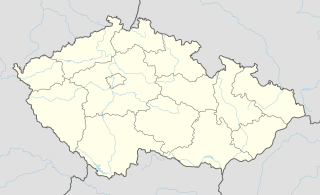Sloupsko-šošůvské jeskyně
| Sloupsko-šošůvské jeskyně
|
||
|---|---|---|
|
Elisabeth Cave |
||
| Location: | between the places Sloup and Šošůvka , Czech Republic | |
|
Geographic location: |
49 ° 24 '37.6 " N , 16 ° 44' 20.5" E | |
|
|
||
| Type: | Stalactite cave | |
| Show cave since: | 1879 | |
| Lighting: | electric | |
| Overall length: | 4200 m | |
| Length of the show cave area: |
1500 m | |
The cave system Sloupsko-Šošůvské jeskyně ( Sloupsko-Šošůvské caves ) located in the northern part of the Moravian Karst in the Czech Republic , between the towns of Sloup and Šošůvka near the town of Blansko . It is one of the four publicly accessible cave systems in the Moravian Karst. The caves are known nationwide for their rich stalactite formations.
description
The caves form an extensive system of halls, passages and chimneys formed in the Devonian limestone of the Moravian Karst. The system is divided into two floors. The upper floor is dry and partially accessible to visitors, the lower floor is traversed by underground watercourses. The average temperature in the dry caves is 7–8 ° C. A total of 4,200 meters of corridors have been explored by speleologists so far . There are five entrances, two of which have been developed for tourist purposes. The main entrance is 8 meters high and 20 meters wide.
The well-known cavities consist of four parts: the Nicová Cave , the Elisabeth Cave , the Staré Skály (Old Rocks) complex and the Šošůvská jeskyně cave . The Elisabeth Cave is the most famous of them. It has excellent acoustics and is therefore occasionally used for chamber music concerts. The complex also includes the Kůlna cave , in which remains of prehistoric settlement have been found. The fragile and colored sinter formations with stalactites up to three meters high are characteristic of the entire system . The Sloupsko-šošůvské jeskyně complex is connected by siphons to the largest Czech cave, the amateur cave. This creates a cave system with a total length of almost 35 kilometers.
The caves are an important wintering area for bats; 17 bat species were counted . The Sloupsko-šošůvské jeskyně nature reserve was proclaimed in 2004 on 7.80 hectares to protect the karst formations and cave fauna.
history
Inside the caves there were remains of hyenas , lions and, above all, of cave bears from the Upper Pleistocene . Historical sources speak of up to 300 bear skulls, even complete skeletons were among the finds. Parts of the cave system were also places of residence and refuge for ancient people. The jaws of a Neanderthal child, stone, antler and bone tools up to 120,000 years old and objects from the Bronze Age were found .
In 1669, the Brno city physician Johanes Ferdinandus Hertod von Todtenfeld described the caves at Sloup for the first time in his work Tartaro – Mastix Moraviae . The abyss that bears his name was discovered by the mathematician and physicist Johannes Anton Nagel in 1748. The first tourists came to Sloup at the end of the 19th century. At that time, three caves were open to the public, the Elisabeth cave had had electric lighting since 1879. The remaining part of the cave system was mainly explored in the years 1889–1915, among others by the well-known scholar Karel Absolon . At the beginning of the 20th century, the caves were connected by artificial breakthroughs. The last extensive reconstruction of the cave complex and expansion of the accessible route took place in 1997–1999. A cave has been used for speleotherapy since then .
At the end of 2005, speleologists managed for the first time to cross the underground rivers Sloupský potok and Punkva and thus to get from the Sloupsko-šošůvské jeskyně complex to the amateur cave.
Show cave area
The caves are accessible from March to November. The show cave area is 1.5 kilometers long and leads over the Nicová Cave and the Elisabeth Cave through an artificially created passage into the largest part of the cave system - the Staré skály. This part begins with the mighty Gothic passage, which ends with the 65-meter-deep Stupňovitá propast abyss. The next stop is at the Kolmá abyss, from which one enters the rooms discovered by Karel Absolon in 1900. The Nagelova propast abyss is spanned by two bridges. From the roof to the water level of the Sloupský potok it measures about 90 meters. From here the path leads to the Trámová chodba corridor, which turns into the 260-meter-long Stříbrná chodba corridor. An artificial entrance leads to the somewhat smaller Šošůvská jeskyně cave with its rich stalactite decorations. Via the Brouškova pohádková síň hall with its unique stalagmite “Svícen” (candlestick) you can get to the Riegrova síň hall. Finally, the Černá propast abyss extends to the water level of Sloupský potok at a depth of 70 meters.
The Sloupské údolí valley
There are two striking natural phenomena in front of the cave. The first is a complex of three boulders that lie next to each other on the rock above the parking lot. They are called Otec, matka a syn, (father, mother and son). A dominant feature of the landscape is the Hřebenáč limestone column , where the Sloupský creek seeps into the abyss. The approximately 20 meter high rock probably gave the village of Sloup (Czech: column) its name.
literature
- Musil, Rudolf: Sloupsko-šošůvské jeskyně - jeskyní bludiště pod bradinami . Gloria, 2002.
Web links
- punkevni-jeskyne.cz
- Description of the caves in Czech:
- Photo gallery



